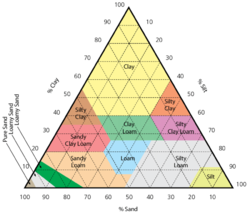Hydrophobic soil: Difference between revisions
No edit summary |
No edit summary |
||
| Line 9: | Line 9: | ||
== Distribution == | == Distribution == | ||
[[File:triangle.png| | [[File:triangle.png|250px|thumb|left|Source: [https://researchgate.net ResearchGate] | ||
Image: Soil textural classification triangle]] | Image: Soil textural classification triangle]] | ||
| Line 35: | Line 36: | ||
Doerr, S.H., et al. “Soil Water Repellency: Its Causes, Characteristics and Hydro-Geomorphological Significance.” Earth Science Reviews, vol. 51, no. 1-4, Aug. 2000, pp. 33–65. | Doerr, S.H., et al. “Soil Water Repellency: Its Causes, Characteristics and Hydro-Geomorphological Significance.” Earth Science Reviews, vol. 51, no. 1-4, Aug. 2000, pp. 33–65. | ||
Jurez, Laura Daniela, et al. “Stabilization of Colombian Lateritic Soil with a Hydrophobic Compound (Organosilane).” International Journal of Pavement Research and Technology, vol. 11, no. 6, Nov. 2018, pp. 639–646., apps.webofknowledge.com.gate.lib.buffalo.edu/CitedFullRecord.do?product=WOS&colName=WOS&SID=8DQlpZIc13phMJI24Hm&search_mode=CitedFullRecord&isickref=WOS:000087736400012. | |||
Rasa, Kimmo, et al. “Water Repellency of Clay, Sand and Organic Soils in Finland.” AGRICULTURAL AND FOOD SCIENCE, vol. 16, 2007, pp. 267–277. | Rasa, Kimmo, et al. “Water Repellency of Clay, Sand and Organic Soils in Finland.” AGRICULTURAL AND FOOD SCIENCE, vol. 16, 2007, pp. 267–277. | ||
Revision as of 09:50, 25 April 2019

Definition & Entomology
The term “hydrophobic” stems from the Greek prefix- hudōr, ‘water’ and the Latin and Greek suffix- -φοβία, ‘-phobía’. It is biologically defined as tending to repel or mix with water. Hydrophobicity is introduced as a property of soils when waxy, organic substances coat the surface area of soil particles, essentially making the soil impenetrable by any precipitation or other liquids. This water repellent layer is highly variable in effects depending on where the given site is.
Distribution

Hydrophobic soils are expected to be more prevalent in hot, temperate climates (Rasa) typically holding a higher sand content than silt or clay. The increased particulate surface area of sand, sandy loam, and loamy sand soils create the most attraction with organic substrates out of all soil classifications. Water repellent soils can be located in the United States, Canada, Finland (Rasa), Australia (Robichaud), Mexico (Alanis), Portugal (Doerr Thomas),
Consequences
Loss of Agriculture
Increased Erosion
Sudden wildfires
Treatment and Sampling
The most commonly documented treatment of hydrophobic soil is done by adding moisturizing clay agents in a process referred to simply as “claying”. Because the most vulnerable soils tend to be sand-based, clay mixtures aid the current soil in retaining more water and allowing precipitation to seep through a To determine if a soil site must undergo treatment, a few things must be determined regarding the sample. The first and most straight-forward method of testing for hydrophobicity is the water droplet method, where 1-2 droplets are put directly onto the soil. Initial water intake of wettable soil occurs rapidly because of the strong attraction between the water molecules and dry soil aggregates. (DeBano 5). However, the water infiltration rate of repellent soils is either very slow or non-existent. Therefore, repellent soil will cause naturally occurring precipitation and the experimental water droplet to bead on top of the sample, if or until it is completely absorbed.
Sources
Cesarano, Gaspare. “The Influence of Plant Litter on Soil Water Repellency: Insight from 13C NMR Spectroscopy.” PloS One, vol. 11, no. 3, Mar. 2016.
DeBano, Leonard F. “Water Repellent Soils: a State-of-the-Art.” United States Department of Agriculture Forest Service Pacific Southwest Forest and Range Experiment Station: General Technical Report PSW-4, Mar. 1981, pp. 4–20.
Doerr, S.H., et al. “Soil Water Repellency: Its Causes, Characteristics and Hydro-Geomorphological Significance.” Earth Science Reviews, vol. 51, no. 1-4, Aug. 2000, pp. 33–65.
Jurez, Laura Daniela, et al. “Stabilization of Colombian Lateritic Soil with a Hydrophobic Compound (Organosilane).” International Journal of Pavement Research and Technology, vol. 11, no. 6, Nov. 2018, pp. 639–646., apps.webofknowledge.com.gate.lib.buffalo.edu/CitedFullRecord.do?product=WOS&colName=WOS&SID=8DQlpZIc13phMJI24Hm&search_mode=CitedFullRecord&isickref=WOS:000087736400012.
Rasa, Kimmo, et al. “Water Repellency of Clay, Sand and Organic Soils in Finland.” AGRICULTURAL AND FOOD SCIENCE, vol. 16, 2007, pp. 267–277.
Robichaud, P.R., et al. “A Probabilistic Approach to Modeling Postfire Erosion after the 2009 Australian Bushfires.” 18th World IMACS / MODSIM Congress, July 2009, pp. 1–7.
White, Carleton S. “Homogenization of the Soil Surface Following Fire in Semiarid Grasslands.” Rangeland Ecology and Management, vol. 64, no. 4, 2011, pp. 414–418.